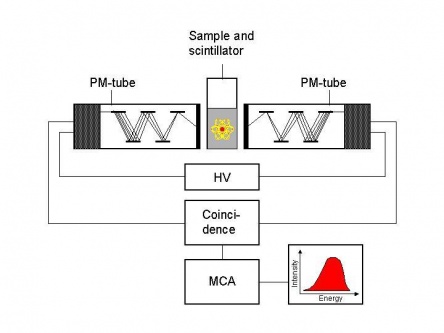Introduction Liquid Scintillation
Written and developed by Prof. Tor Bjørnstad (IFE/UiO)
Return to Main
Basically, the liquid scintillation process is the conversion of the energy of a radioactive decay event into photons of light in a liquid. Photomultipliers (PM-tubes) detect the emission of light and convert the light pulse into an electrical signal. The intensity of the light pulse (number of photons emitted) is proportional to the energy of the radioactive decay event. Further, the size (height) of the electrical pulse is proportional to the intensity of the light and, accordingly, also proportional to the energy of the decay event.
The electrical pulse can be handled in an electronic system, which measures its height and stores the events in an intensity-energy array, a so-called multichannel analyzer (MCA) system. Thus, an energy spectrum can be recorded of the decaying radionuclide.
In this way liquid scintillation counting (LSC) is a detection technique for radioactivity. Normally, the radioactive substance is intimately mixed with the detector which is the liquid scintillator cocktail. The radioactive substance should then, preferably, be in liquid form.
The emission of light in the liquid scintillator is an isotropic process. By applying two PM-tubes instead of only one the noise in the detection process (background counts not due to the decay process) may then be reduced. Only those events that are recorded in both PM-tubes simultaneously (in coincidence within the required time window, often 10-30 ns width) are recorded as “true” counts. A principle sketch of the detection system is given in the figure above.
